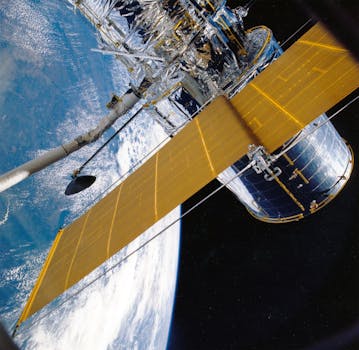
MEO Satellites: Introduction to Medium Earth Orbit Technology
MEO satellites, or Medium Earth Orbit satellites, are a type of satellite that operates in a medium Earth orbit, approximately 2,000 to 36,000 kilometers above the Earth’s surface. This orbit allows MEO satellites to provide global coverage with fewer satellites compared to Low Earth Orbit (LEO) satellites, while also offering faster and more reliable connections compared to Geostationary Orbit (GEO) satellites.
The Focus Keyword, MEO satellites, have become increasingly important in recent years due to their ability to provide high-speed and low-latency connections, making them ideal for applications such as broadband internet, mobile communications, and navigation. In this article, we will delve into the world of MEO satellites, exploring their history, technology, and applications, as well as their benefits and challenges.
History and Development of MEO Satellites
The concept of MEO satellites dates back to the 1960s, when the Soviet Union launched the first Molniya satellite, which operated in a highly elliptical medium Earth orbit. However, it wasn’t until the 1990s that MEO satellites began to gain popularity, with the launch of the first Globalstar constellation, which provided mobile satellite communications services. Since then, several other constellations have been launched, including O3b (Other 3 Billion) and SES’s O3b mPOWER, which offer high-speed broadband internet services.
One of the key advantages of MEO satellites is their ability to provide global coverage with fewer satellites compared to LEO satellites. For example, the O3b constellation consists of 20 satellites, which provide coverage of nearly 100% of the world’s population. In contrast, LEO constellations such as OneWeb and SpaceX’s Starlink require hundreds or even thousands of satellites to achieve similar coverage.
Technology and Applications of MEO Satellites
MEO satellites use a range of technologies to provide high-speed and low-latency connections, including advanced antenna systems, high-gain amplifiers, and sophisticated signal processing algorithms. They also utilize a variety of frequency bands, including Ka-band, Ku-band, and C-band, to provide a range of services, from broadband internet to mobile communications and navigation.
One of the most significant applications of MEO satellites is in the provision of broadband internet services, particularly in remote and underserved areas where traditional fiber-optic or wireless connections are not available. MEO satellites can provide speeds of up to 1 Gbps, making them ideal for applications such as video streaming, online gaming, and cloud computing.
Benefits and Challenges of MEO Satellites
MEO satellites offer a range of benefits, including faster and more reliable connections, global coverage, and lower latency compared to GEO satellites. They also have a lower cost per bit compared to traditional satellite communications systems, making them an attractive option for a range of applications.
However, MEO satellites also face several challenges, including interference from other satellites and terrestrial systems, regulatory hurdles, and the need for advanced technology to provide high-speed and low-latency connections. Additionally, the launch and operation of MEO satellites require significant investment, making them a costly proposition for many organizations.






